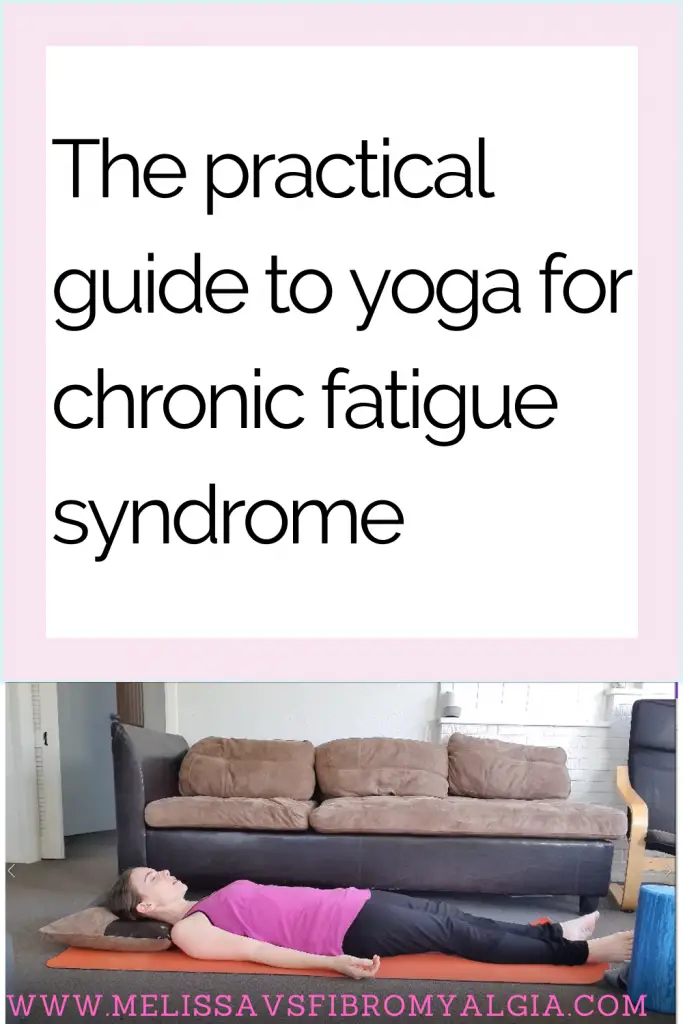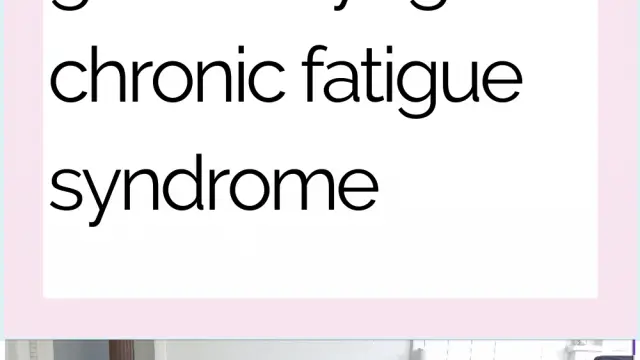Last Updated on December 23, 2021 by melissanreynolds
Can you do yoga with Chronic Fatigue Syndrome (CFS)? At first glance, perhaps the thought of yoga (as you currently envision it) is an absolute no-go. Profound, unrelenting fatigue coupled with pain, brain fog, post-exertion malaise and more don’t seem like they lend themselves to yoga.
But what if I told you “yoga” isn’t what you think. It isn’t those perfectly curated pictures on Instagram or those intense flows on YouTube. Although, they are a part of it.

What if I told you that I practiced “yoga” throughout the profound fatigue and nausea that often occurs in first trimester of pregnancy with fibromyalgia (chronic pain and fatigue). And continued to do so as my severe pelvis issues saw me on crutches.
The concept of yoga is so much more than any length of class or type of practice. It incorporates physical practice which can be done on the bed, in a chair and on the floor. But it also incorporates breathwork and meditation.
When I begin working with a new student I start where they are. And this is especially pertinent when working with CFS.
If you are wise in your experiments, yoga can be a gentle way to achieve some deeper rest, mindful stretching for tense muscles and a lovely way to relax.
I have been wanting to share this article for a long time, but I wanted to wait until I had some classes ready on YouTube so that you can actually try them out – rather than me just telling you they may help. I would love for you to be able to experience that help. If one class here helps you just a little, I will be so happy.
How to approach the idea of yoga with chronic fatigue syndrome?
First, ask your medical team if they recommend any of the physical practice and if they advise against any specific movements.
Then, consider what practice you might start with. What benefits are you hoping to achieve and what do you feel able to manage?
If you choose a physical practice, consider what you think you could start with and pull it back by at least 30%. For example, if you think you could do a 15 minute bed yoga class, consider a 10 minute one.
Watch the practice through (this is where prerecorded classes are helpful) to get a sense of what movements might be expected. Remember – you don’t need to do every pose offered in a class. You are welcome to stay longer in one that suits or omit completely.
While trying your practice, be mindful of how you are feeling as you go and how every movement makes you feel. If something doesn’t feel good, please do not do it.
It may be best to seek private support for your first practices.

What practices yoga offers that can help CFS:
Bed Yoga is exactly what it sounds like. You can practice on your bed. You can start with mindful breathing, toes point and flex, reclined child’s pose (hug your knees to your chest), single leg twists (release one leg straight out from reclined child’s pose, pull the other bent leg across your body) and stretch your arms above your head in supine mountain.
Bed Yoga
Chair Yoga
Chair Yoga offers a few options. You can do classes fully seated or using the chair for balance. Fully seated classes are a good idea if you are managing orthostatic intolerance. The below class would be best for those with yoga experience and an ability to stand for a good period of time.
Yoga Nidra
Yoga Nidra is a guided meditation practice that I have done nearly every day for several years. As a chronic insomniac with chronic fatigue who cannot nap, it is a life saver. I now know for sure that there is a way to achieve some real, deep rest. The emotional benefits of this alone are worth trying it.
You can do this practice in your bed, with your heat pack. You can do it first thing in the morning, as a rest in the day, after work, before bed, during the night etc. It is pretty adaptable.
Pretty much anyone can do the below “classes”.
Restorative Yoga
Restorative yoga is a type of yoga that was created for those who were injured or unwell. A class consists of a small number of poses for a long period of time. Each pose is set up so that you feel completely relaxed and comfortable. The point is release, not sensation. This induces the relaxation response. The below two poses can be done on your bed.
Please do the Supported Child’s Pose toward the middle of your bed so you have plenty of space when getting up.
Take the time to get yourself comfortable and then release for a good 10-20 minutes in either pose or one after the other.
Read more about restorative yoga and the central nervous system.
Breathwork
It is common for those who are exhausted and in pain to be chest breathers. Breathing in this way can actually cause more pain and fatigue. Deep breathing can also help to activate the rest and digest (relaxation) response.
There are all sorts of breathing practices available in yoga, but the ones I recommend are mindful breathing (focusing on your breath and breathing fully), the simple 4:2:6 breath (inhale for a count of 4, pause for a count of 2 and exhale for a count of 6) and alternate nostril breathing.
I hope that something here has inspired you to give yoga a try. Please know that one practice won’t yield magnificent results. You may feel great after the right type of practice for you, but the benefits add up. A nice goal is 10 minutes a day (breathwork, meditation, one pose, gentle class, restorative yoga, a mix).
Conclusion: Yoga for Chronic Fatigue Syndrome
I hope that this post has shared how and why you might consider trying some yoga tools if you have chronic fatigue syndrome. I know the idea might be daunting, especially when we consider some of the ideas of what yoga is as portrayed in popular media.
In sharing this post and the practical tools (the YouTube videos of practices for you to try), I hope that I have offered something that may be of use to you. Please choose one to look at and then try.
Let us know: Are you going to try any of these?



Such a wonderful collection of resources you’ve provided here. I love your approach. It helps us understand what healing yoga is. So often we’re told to “do” yoga. There is such a wide range of yoga and many are NOT healing for those with chronic pain/ fatigue/Fibromyalgia.
I was hoping this article was about getting me to put my legs over my head and walking on my hands.
Ok so i’d never get my legs back down. 😛
I found yoga useful, specifically DDP Yoga to help me build more strength with less impact. Weights seemed to be too much impact and I couldn’t really increase my strength much since I got lyme.. and these workouts helped me to do that more and even get a bit of a higher intensity workout with lower impact.
Though I did find this style of yoga when I was a good amount into my recovery, it may be too much if somebody is really impacted. Unfortunately I didn’t find these kinds of gentler suggestions at the start, but I found something else useful.
Have you tried Qigong? It really helped me when I first got lyme and I was still able to do it when I was quite fatigued, in the course they also said you can even just imagine it and get results if you can’t yet perform it. Basically I see Qigong as moving meditation, where you use your breath and movement to build energy in your body and create relaxation.
I haven’t tried qi Jong. I have heard loads about it but I’ve been busy with my yoga practice 😀
This is fantastic! I love how thorough it is and the videos bring it to life brilliantly. I often think with yoga that it’s harder to get a proper feel for it when it’s just text.
It sounds like Yoga Nidra has been really beneficial to you. It’s great you’ve been so dedicated to having it as part of your daily routine. I used to do odd bits of yoga many years ago, before fibromyalgia/ME/everything else. I bought a yoga mat a few years ago thinking I’d try it now for the health benefits but alas, the mat is just collecting dust and has never been used. This is great motivation to give it another try!
Caz xx